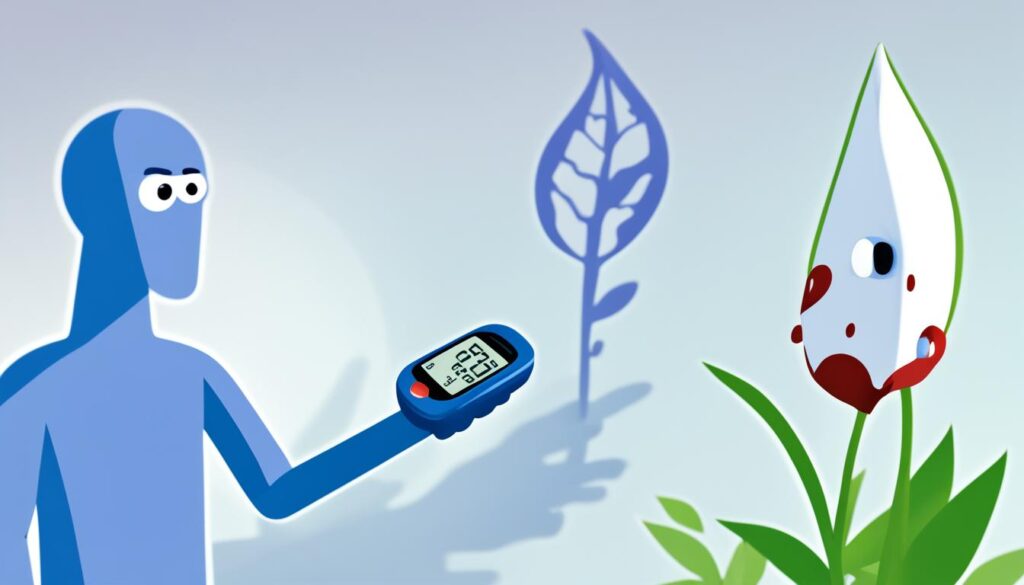|
Getting your Trinity Audio player ready... |
Pancreatic cancer is a strong opponent, but knowing its symptoms is key. Changes in DNA lead to uncontrolled cell growth, forming tumors. These can spread outside the pancreas if not treated.
Table of Contents
ToggleIt’s mostly found in people over 65. Risk factors include smoking, diabetes, pancreatitis, family history, and some genetic syndromes. A poor diet and smoking together can increase the risk the most. Knowing these risk factors can help take control of your health.
Catching pancreatic cancer earlier makes a big difference. Symptoms can include abdominal pain, back pain, weight loss, and jaundice. You may also see light stools, dark urine, itchiness, and diabetes becoming hard to control. Blood clots and fatigue are other signs to look out for.
Remember, these signs aren’t only for pancreatic cancer. Other health issues can also cause them. But, knowing and reacting to these signs early with your doctor is critical. Don’t delay if you notice any troubling changes. Your health is worth taking seriously.
Understanding the Pancreas

The pancreas is a fish-shaped organ found behind your stomach. It’s vital for your digestion and how your body uses energy. The pancreas makes enzymes for digestion and hormones for controlling blood sugar. The pancreatic cancer starts in the pancreas’ ducts. Changes in DNA can cause uncontrolled cell growth, leading to cancer if not treated early.
Anatomy and Function of the Pancreas
The pancreas has different parts, each doing its unique job. Its head is close to the stomach, while the body and tail reach across your abdomen. This organ makes enzymes like amylase and lipase to digest food. It also releases hormones, such as insulin and glucagon, to keep your blood sugar in check.
Role in Digestion and Blood Sugar Regulation
Enzymes and hormones from the pancreas are key for breaking down food and absorbing nutrients. They make sure your body gets what it needs from the food you eat. The pancreas also helps keep your blood sugar levels stable by producing insulin. This keeps you from getting health problems like diabetes.
Who is at Risk for Pancreatic Cancer?

Pancreatic cancer is a severe type of cancer. It’s key to know the risk factors for spotting it early and preventing it. Being old increases the risk. Most patients are over 65. Nearly half of all new cases happen in people 75 or older. This cancer is rare in those under 40.
Lifestyle Factors Contributing to Risk
Some lifestyle choices can raise your odds of getting pancreatic cancer. These include smoking, being diabetic, having pancreatitis, and being overweight. A mix of smoking, diabetes, and a bad diet boosts the risk the most.
Genetic Predisposition and Family History
Your genes can make you more likely to get pancreatic cancer. About 5-10% of patients have a family history of it. If many close relatives had it, your risk is higher. Genetic syndromes like BRCA2 mutations can also up the risk.
Knowing these risk factors is important. Talk with your doctor about any worries. By learning your own risk, you can watch your health better. This way, if pancreatic cancer shows up, you might spot it early for effective treatment.
Pancreatic Cancer Symptoms
It’s vital to notice early and late signs of pancreatic cancer for quick diagnosis and treatment. Sadly, symptoms often don’t show until later stages. This makes it tough to catch early.
Early Warning Signs
Look out for abdominal pain spreading to the back, lack of appetite, and shedding weight without trying. These signs may seem small. But, it’s crucial to notice them early by staying aware of your body.
Advanced Symptoms
As the cancer grows, symptoms like yellow skin and eyes, light stools, dark urine, and an itch may appear. You might also face diabetes that’s hard to control, blood clots, or excessive tiredness. It’s key to know these signs can be from something else, not just pancreatic cancer.
Do you feel these symptoms might be pancreatic cancer? Talk to a doctor right away. Catching it early boosts treatment success and control over the disease.
Abdominal Pain and Discomfort

Abdominal pain is a key sign of pancreatic cancer. It may spread to the back. The pain comes from the tumor pressing on organs and nerves.
It can get worse after eating. This is because the tumor might make it hard for food to go through.
Radiating Back Pain
With pancreatic cancer, you might feel pain that moves to the back. Many patients report this symptom. The pain can be dull or sharp, and it gets worse with certain movements.
Unexplained Weight Loss and Appetite Changes
Unexplained weight loss and a poor appetite are often signs of pancreatic cancer. The illness can destroy cells that make insulin. This can change blood sugar and lead to less appetite.

A tumor can also press on the stomach and make eating hard. This can cause even more weight loss.
When cancer causes weight loss, the body starts to burn more calories. It breaks down muscles, and you may not feel hungry. This happens because the tumor creates substances that affect how your body uses nutrients.
Pancreatic cancer often leads to severe weight loss and malnutrition. This can make it hard to undergo treatment and stay in the hospital shorter. There are steps to help avoid this, such as learning about nutrition and taking special supplements or medications.
If you have pancreatic cancer, a dietitian can help you eat better. They might suggest foods that are high in calories or drinks that provide extra nutrients. It’s also important to stay hydrated and do light exercises like walking to stay strong.
Appetite changes and weight loss are common in pancreatic cancer. In the final weeks of life, a person might eat less. This can be due to feeling sick, in pain, or tired.
Staying active can help keep your appetite up and your muscles strong. Sometimes, patients might need extra help with eating. This could include special food, drinks, or nutrition given through a vein.
It’s hard for families when a loved one with pancreatic cancer isn’t eating well. Doctors, nurses, and dietitians can offer support. There’s a helpful booklet about pancreatic cancer and end-of-life care that can guide you through these tough times.
Jaundice and Related Symptoms
Jaundice, or yellow skin and eyes, is a common early sign of pancreatic cancer. It’s due to a blockage in the bile duct that causes a buildup of bilirubin. Tumors in the head of the pancreas can press on the bile duct, leading to jaundice earlier.
Yellowing of Skin and Eyes
Jaundice is usual in newborns, affecting about 60 percent of them. For pancreatic cancer patients, it signals a severe issue. The skin and eyes turn yellow from high bilirubin levels, leading to itchy skin, dark urine, and light-colored stools.
Dark Urine and Light-Colored Stools
Pancreatic cancer patients might notice dark urine and greasy, light-colored stools. These issues result from bilirubin not being able to leave the body because of the bile duct blockage.
Itchy Skin
Itchy skin can also happen in pancreatic cancer. High levels of bilirubin in the blood, from the blockage, cause this problem. It’s another effect of the bile duct issue.
Nausea and Vomiting
Nausea and vomiting can often be signs of pancreatic cancer. With this condition, a tumor can squeeze the stomach’s far end. This squeezing can block food, leading to unpleasant feelings and even pain.
This can make life tough, with sickness after eating being common. If you face persistent or strong nausea and vomiting, don’t hesitate to reach out for help. Your healthcare provider can offer advice. They can help you find ways to cope and suggest treatments to soothe the discomfort.
Finding and treating the root cause, like the pressure on your stomach, is key. Your doctor might give you meds to ease the nausea. Or, sometimes, a simple stent placement in the duodenum can be a big relief. This means that managing pancreatic cancer’s effects on your stomach can improve, helping you keep up with life.
Gallbladder or Liver Enlargement
Pancreatic cancer may enlarge the gallbladder or liver. This happens when cancer blocks the bile duct. Bile then builds up, enlarging the gallbladder.
Enlargement can also occur if cancer spreads to the liver. A doctor might detect these enlarged organs during a check-up.
Blood Clots and Thrombosis
One sign of pancreatic cancer is the development of blood clots. These can form in the legs (deep vein thrombosis or DVT) or lungs (pulmonary embolism). They may show up first, even before other pancreatic cancer symptoms. Having pancreatic cancer makes blood clots more likely, but they can also come from other health issues.
DVT symptoms can include pain or swelling in one leg. That leg might feel tender, warm, or look different. Pulmonary embolism, caused by a clot in the lungs, can lead to breathing troubles or chest pain. If someone has advanced pancreatic cancer, they have a higher chance of experiencing these symptoms.
Risks for blood clots in pancreatic cancer patients include being over 60 or obese, smoking, or having had hormone therapy. Other risk factors are varicose veins, a family history of clots, or certain genetic conditions. Staying active and following your doctor’s advice can lower the risk. Sometimes, patients on chemotherapy need blood thinners. But, this isn’t often necessary with radiotherapy for pancreatic cancer.
To diagnose blood clots, doctors may use ultrasound for DVT or CTPA for pulmonary embolism. Clots can be treated with anticoagulants like DOACs or LMWHs without stopping cancer treatment. Yet, blood thinners can lead to more bruising or bleeding. Patients should know about these possible side effects first.
Diabetes as a Potential Sign
Pancreatic cancer may lead to diabetes or changes in blood sugar levels. The tumor can harm cells that make insulin in the pancreas. This can show up as increased thirst, hunger, and more trips to the bathroom. Yet, the blood sugar shifts may not always be a sign of pancreatic cancer. Doctors can find these issues with tests.
In a 2008 study, 56% of those with pancreatic cancer-linked diabetes had the disease. A 2005 meta-analysis also stated that those with type-II diabetes face a higher risk of pancreatic cancer. Another 2005 study showed that the chance of getting pancreatic cancer after diabetes diagnosis is significant.
Since 1958, diabetes has been linked to pancreatic cancer. In 2008, the American Diabetes Association shared advice on diabetes care. They suggested guidelines that might help those facing pancreatic cancer too.

A 2004 study looked into how ethanol and other factors affect the pancreas under ultrasound. Another study from 2002 uncovered pancreatic cancer in diabetes patients through pancreatography. In 2004, there were also discussions about imaging the pancreas in diabetes patients over 50 with sudden symptoms.
Diagnostic Tests and Procedures
If your doctor thinks you might have pancreatic cancer, they will start with several tests. These tests help confirm the diagnosis and show how much the cancer has spread. Knowing this information is key to choosing the best treatment.
Imaging Tests
Tests like CT scans, MRIs, and PET scans are used. They create detailed images of the pancreas and nearby tissues. This lets the healthcare team see any tumors clearly. Sometimes, an endoscopic ultrasound (EUS) is also done. It shows detailed pictures of the digestive system and the pancreas.
Blood Tests and Tumor Markers
Blood tests can show if certain proteins are higher than normal. These proteins might mean pancreatic cancer is present. One of these proteins is CA 19-9. But these tests alone are not enough to be sure of a diagnosis.
Biopsy Techniques
A biopsy is often needed to make a final diagnosis. In a biopsy, a small piece of tissue from the pancreas is taken and then looked at under a microscope. This is the most certain way to find out if there are cancer cells and what type they are.
Early Detection and Screening
It’s vital to find pancreatic cancer early for better treatment. Often, it’s not caught until later stages. Those with a family history or specific genetic syndromes should have regular screening. By knowing your risks, you can watch your health closely.
Risk Assessment and Genetic Counseling
Genetic counseling helps find those at risk for pancreatic cancer. Through testing, doctors can see if you have genetic issues that make cancer more likely. If you’re at risk, your healthcare team will help with the right screening and monitoring to find cancer early.
Research aims to create better tests to find pancreatic cancer sooner, especially for those more likely to get it. By keeping up with your health and staying informed, you could catch the cancer when it’s most treatable.
Treatment Options and Management
The approach to treating pancreatic cancer is complex, focusing on what the patient needs and the disease’s stage. Doctors may suggest a mix of treatments based on individual circumstances.
Surgery
Surgery might be an option for those in the early stages of pancreatic cancer. The surgery type varies by tumor size and location, and the patient’s health. Sometimes, surgeons need to remove the entire pancreas. But, other times, just part of it can be taken out.
Chemotherapy and Radiation Therapy
Chemotherapy and radiation are important treatments for pancreas cancer. They can be used by themselves or together. Before surgery, they might be applied to reduce the tumor’s size. After surgery, they can kill any remaining cancer cells and stop the disease from coming back. If the cancer is advanced, these treatments help slow down the disease and ease symptoms.
Palliative Care
If the cancer is advanced and surgery isn’t an option, palliative care is essential. It’s about making life better by managing pain, nausea, and helping with weight loss. Palliative care also supports the patient and their family emotionally. The main goal is to improve the patient’s quality of life during treatment.
Conclusion
It’s really important to spot the early signs of pancreatic cancer. Knowing the pancreas and what it does can help. This, along with knowing the risk factors and signs of pancreatic cancer, lets you act fast for your health.
Figures show this cancer’s big impact around the world. There are about 279,000 new cases each year but only a 3% survival rate after five years. Yet, research is ongoing to find new and better ways to fight what causes pancreatic cancer.
Being on the lookout for early signs is key. It means you can get help right away. Although pancreatic cancer is tough, thanks to hardworking doctors and new treatments, there is hope in the battle against it.
FAQ
What causes pancreatic cancer?
According to Dr. Chee-Chee Stucky at Mayo Clinic, pancreatic cancer often starts in the pancreas ducts. Changes in the cellular DNA lead to uncontrolled cell increase. This causes tumor formation. The cancer can spread outside the pancreas if not treated.
What are the symptoms of pancreatic cancer?
Symptoms might not show until the cancer is further along. Signs include stomach pain that goes to the back, losing weight without trying, and a lack of appetite. You might also see yellow skin or eyes, light stools, dark urine, itchiness, and diabetes that’s hard to manage. Blood clots or feeling tired are also common signs.
Who is at risk for developing pancreatic cancer?
Pancreatic cancer is more common after you turn 65. If you smoke, have diabetes, or experience ongoing pancreas issues, you might have a higher risk. A family history of the disease, certain genetic issues, and being overweight also increase the risk.
How is pancreatic cancer diagnosed?
Doctors use tests like CT scans, MRIs, PET scans, and specific blood tests to diagnose pancreatic cancer. They look for high tumor marker levels. Yet, a biopsy is often needed to be sure.
What are the treatment options for pancreatic cancer?
Pancreatic cancer treatment is based on the cancer stage and the patient’s health. It may involve surgery to remove the tumor, chemo, radiotherapy, or a mix of these. Managing symptoms to make the patient more comfortable is also key.
Source Links
- https://www.mayoclinic.org/diseases-conditions/pancreatic-cancer/symptoms-causes/syc-20355421
- https://www.cancer.org/cancer/types/pancreatic-cancer/detection-diagnosis-staging/signs-and-symptoms.html
- https://my.clevelandclinic.org/health/diseases/15806-pancreatic-cancer
- https://www.cancerresearchuk.org/about-cancer/pancreatic-cancer/risks-causes
- https://www.hopkinsmedicine.org/health/conditions-and-diseases/pancreatic-cancer/pancreatic-cancer-risk-factors
- https://pancan.org/facing-pancreatic-cancer/symptoms/


